You don’t need a barbell, fancy machines, or even a gym membership to build bigger, stronger shoulders.
All you need is a pair of dumbbells—and the right exercises.
And in my experience training thousands of people, the most effective dumbbell shoulder exercises are:
- Standing dumbbell shoulder press
- Seated dumbbell shoulder press
- Arnold press
- Dumbbell front raise
- Dumbbell side lateral raise
- Dumbbell upright row
- Dumbbell rear lateral raise
- Dumbbell rear delt row
- Dumbbell face pull
In this guide, you’ll learn exactly how to do each one correctly, why they work so well, and how to combine them into two evidence-based dumbbell shoulder workouts for building size, strength, and stability—whether you’re training at home or in the gym.
Key Takeaways
- Effective dumbbell shoulder workouts train all three heads of the deltoids—front, side, and rear—as well as the rotator cuff muscles.
- The most effective dumbbell shoulder exercises are the standing and seated shoulder press, Arnold press, front raise, side and rear lateral raise, upright row, rear delt row, and dumbbell face pull.
- Dumbbell shoulder exercises are so effective because they allow you to train each side of your body independently, move freely through a greater range of motion, and activate your muscles to a high degree.
- To get the best results from your shoulder workouts with dumbbells, train close to failure and strive to lift heavier weights over time.
- To accelerate your progress, consider using a high-quality protein powder to help you reach your daily protein target, creatine to support recovery and muscle growth, and a pre-workout to enhance energy, focus, and performance.
Table of Contents
+
Shoulder Anatomy
To get the most from your dumbbell shoulder workouts, it helps to understand the muscles you’re training.
Your deltoids—or “delts”—are the large shoulder muscles responsible for moving your arms forward, upward, and backward. Each one has three heads: The anterior deltoid (“front delt”), the lateral deltoid (“side delt”), and the posterior deltoid (“rear delt”). A dumbbell shoulder workout should target all three.
Beneath the delts are the rotator cuff muscles—four smaller muscles that stabilize your shoulder joint and support its wide range of motion:
- Supraspinatus
- Infraspinatus
- Teres minor
- Subscapularis
Here’s how everything looks on your body:
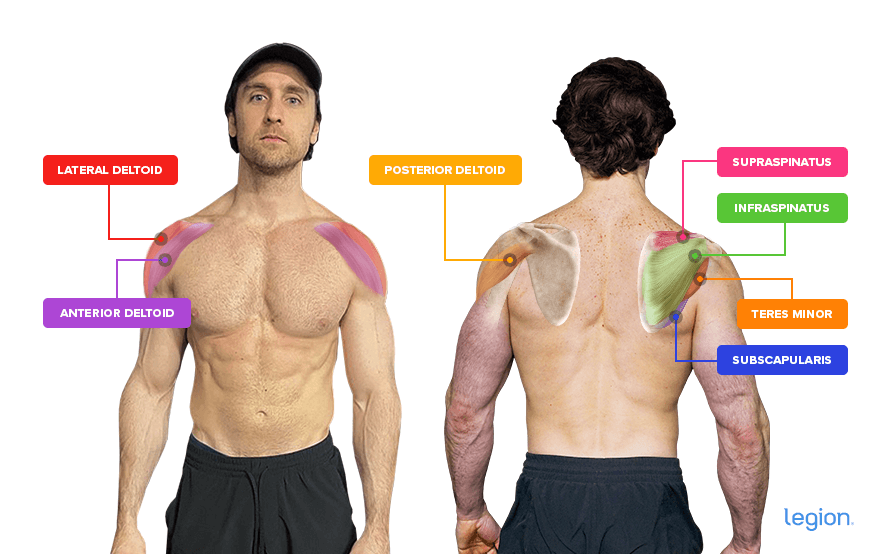
For the best results, choose shoulder exercises with dumbbells that train each delt head and develop rotator cuff strength and shoulder stability.
The 9 Best Dumbbell Shoulder Exercises for Size, Strength, and Stability
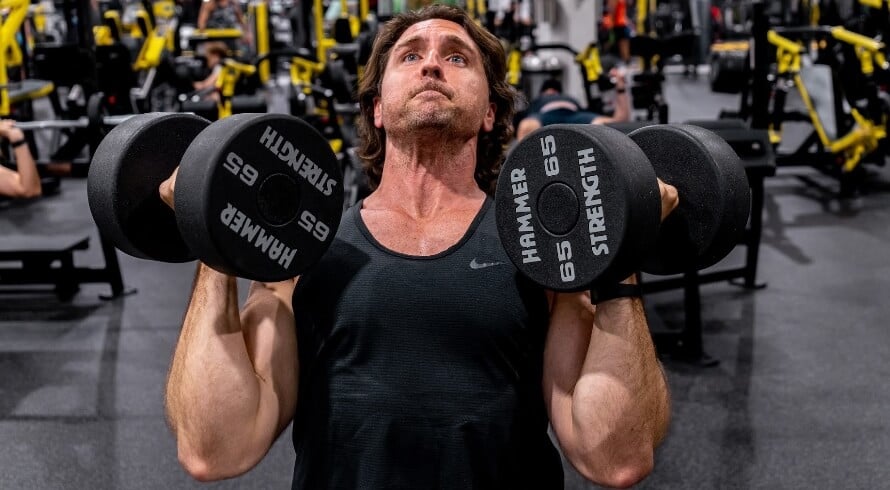
Below are the best dumbbell shoulder exercises for developing all three heads of your delts and strengthening your rotator cuff muscles.
They’re highly effective because they train your shoulders through long ranges of motion, allow you to lift heavy weights, and make it easy to apply progressive overload—all essential for muscle growth and joint health.
1. Standing Dumbbell Shoulder Press
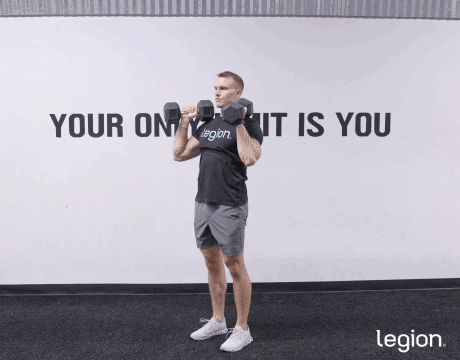
Why: The standing dumbbell shoulder press is arguably the best dumbbell shoulder exercises for building size and strength. It trains all three heads of the delts and allows you to lift heavy weights safely and progress regularly. That’s why all great shoulder workouts with dumbbells revolve around it.
How to:
- Stand upright and hold a dumbbell in each hand
- Hoist the dumbbells up so you’re holding them just above your shoulders with your palms facing away from you.
- Press the dumbbells toward the ceiling until your arms are straight.
- Lower the dumbbells and return to the starting position.
2. Seated Dumbbell Shoulder Press
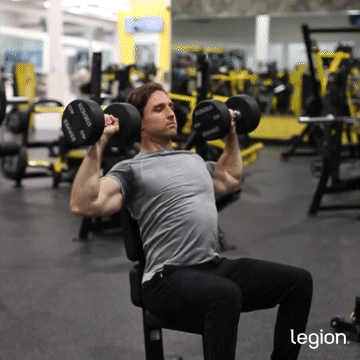
Why: The seated shoulder press is a staple in many dumbbell shoulder workouts because it lets you lift more weight than standing variations and demands less stabilization, coordination, and balance.
That makes it one of the best dumbbell exercises for bigger shoulders, especially if you’re a beginner who finds standing presses tricky to control.
How to:
- Sit on an upright bench and hold a dumbbell in each hand, resting them on your thighs.
- Hoist the dumbbells up so you’re holding them just above your shoulders with your palms facing away from you.
- Press the dumbbells toward the ceiling until your arms are straight.
- Lower the dumbbells and return to the starting position.
READ MORE: How to Perfect the Seated Dumbbell Shoulder Press
3. Arnold Press
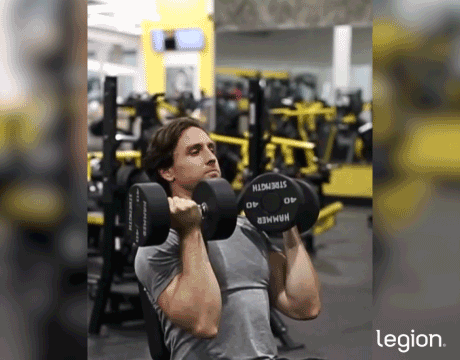
Why: The Arnold press is one of the most effective dumbbell shoulder exercises for balanced shoulder development. Its unique range of motion emphasizes the side delts more than standard presses, helping you build wider, more proportional shoulders.
How to:
- Sit on an upright bench and hold a dumbbell in each hand, resting them on your thighs.
- Hoist the dumbbells up so you’re holding them just in front of your shoulders with your palms facing you.
- Press the dumbbells straight overhead while rotating your wrists until your arms are straight and your palms are facing away from you.
- Reverse the movement and return to the starting position.
READ MORE: How to Do the Seated Arnold Press: Form & Variations
4. Dumbbell Front Raise
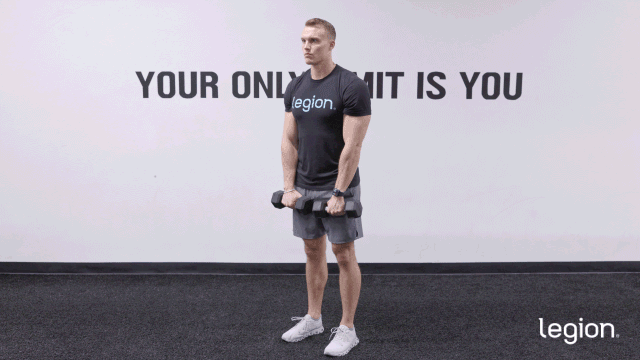
Why: The dumbbell front raise isolates the front delts, making it a useful addition to your “DB” shoulder workouts if pressing movements aren’t an option due to injury. It’s also a great way to add extra front delt volume when needed.
How to:
- Stand up straight with a dumbbell in each hand.
- Raise the dumbbells out in front. Continue raising your arms until your upper arm is parallel to the floor.
- Reverse the movement and return to the starting position.
5. Dumbbell Side Lateral Raise
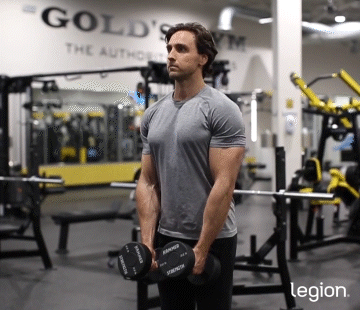
Why: There’s no better dumbbell shoulder exercise for training the side delts than the dumbbell side raise. Developing this part of your shoulders is vital to building that broad, capped look many people want.
How to:
- Stand up straight with a dumbbell in each hand.
- Raise the dumbbells out to your sides until your upper arm is parallel to the floor.
- Reverse the movement and return to the starting position.
READ MORE: How to Do Lateral Raises: Form, Mistakes, & Variations
6. Dumbbell Upright Row
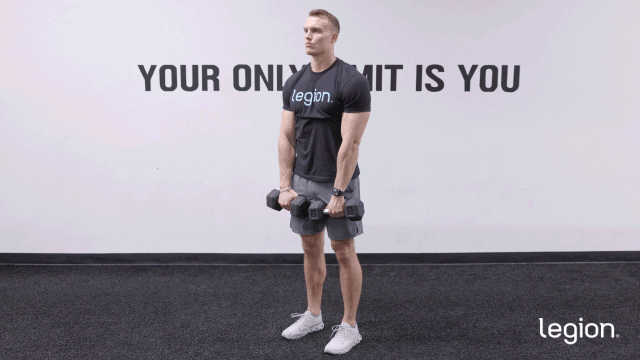
Why: The dumbbell upright row is another excellent exercise for developing the side and rear delts, making it a smart addition to any well-rounded deltoid workout with dumbbells.
How to:
- Stand upright with a dumbbell in each hand.
- Hold the dumbbells in front of your thighs with your palms facing you.
- Lift the weights straight upward until they’re at chest height, keeping your elbows higher than your forearms throughout the movement.
- Reverse the movement and return to the starting position.
7. Dumbbell Rear Lateral Raise
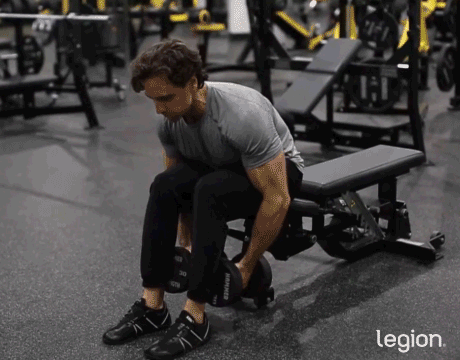
Why: The dumbbell rear lateral raise is a fantastic dumbbell shoulder exercise for isolating the rear delts. It also trains your traps and upper back, helping you build a thicker, more complete upper body.
How to:
- Whether standing or seated, bend at the hips so that your upper body is as close to parallel to the floor as possible.
- Hold a dumbbell in each hand, and while keeping your back flat, lift the dumbbells out to the side until your upper arm is parallel to the floor. As you lift the dumbbells, squeeze your shoulder blades together.
- Reverse the movement and return to the starting position.
READ MORE: How to Do the Dumbbell Rear Lateral Raise: Form, Benefits, & Variations
8. Dumbbell Rear Delt Row
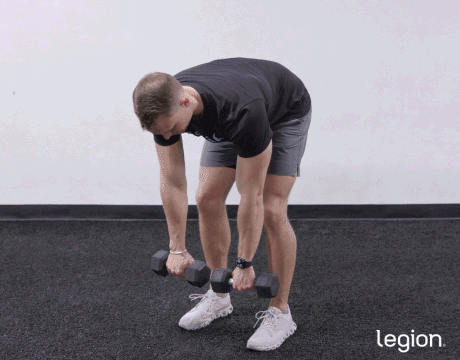
Why: By rowing the weights to your chest instead of your stomach (as you would in a regular dumbbell row), you reduce the lats’ involvement, making the dumbbell rear delt row an excellent dumbbell shoulder exercise for isolating the backs of your shoulders.
How to:
- While holding a dumbbell in each hand, position your feet shoulder-width apart with your toes pointed slightly outward.
- Bend over and flatten your back so it’s roughly parallel to the floor, and let your arms hang straight down.
- Pull the dumbbells to your mid-chest, flaring your elbows at about a 60-degree angle relative to your body.
- Reverse the movement and return to the starting position.
9. Dumbbell Face Pull
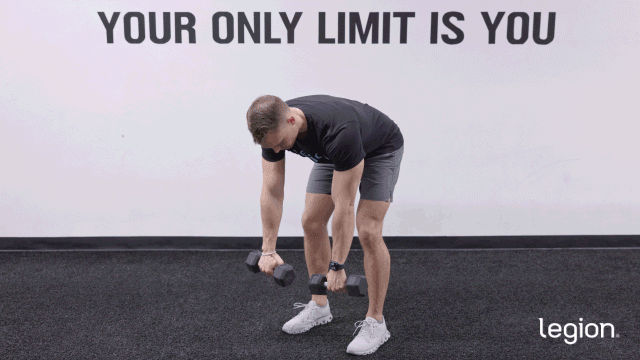
Why: The dumbbell face pull strengthens your rear delts and rotator cuff—two areas that often get overlooked in dumbbell shoulder workouts. Training these muscles is important for improving posture, stability, and long-term shoulder health.
How to:
- While holding a dumbbell in each hand, stand with your feet shoulder-width apart with your toes pointed slightly outward.
- Bend over at the waist until your back forms a 45-degree angle with the floor, and allow your arms to hang straight down.
- Keeping your upper arms flared 90 degrees from your torso, pull the dumbbells upward and apart until they’re on either side of your face.
- Reverse the movement and return to the starting position.
The Best Shoulder Workouts with Dumbbells

These big shoulder workouts with dumbbells combine the most effective exercises with the right amount of volume and intensity to help you build shoulder size, strength, and stability.
To get the best results, do Dumbbell Shoulder Workout #1 once per week for 8-to-10 weeks, then take a deload before switching to Dumbbell Shoulder Workout #2 for another 8-to-10 weeks.
From there, continue alternating between the workouts every 8-to-10 weeks of training, separating each “block” with a deload.
Dumbbell Shoulder Workout #1
- Standing Dumbbell Shoulder Press: 3 sets | 4-to-6 reps | 3-to-5 min rest
- Arnold Press: 3 sets | 4-to-6 reps | 3-to-5 min rest
- Dumbbell Side Lateral Raise: 3 sets | 6-to-8 reps | 2-to-3 min rest
- Dumbbell Rear Lateral Raise: 3 sets | 6-to-8 reps | 2-to-3 min rest
Dumbbell Shoulder Workout #2
- Seated Dumbbell Shoulder Press: 3 sets | 4-to-6 reps | 3-to-5 min rest
- Dumbbell Upright Row: 3 sets | 6-to-8 reps | 2-to-3 min rest
- Dumbbell Rear Delt Row: 3 sets | 6-to-8 reps | 2-to-3 min rest
- Dumbbell Face Pull: 3 sets | 8-to-10 reps | 2-to-3 min rest
3 Dumbbell Shoulder Workout Tips
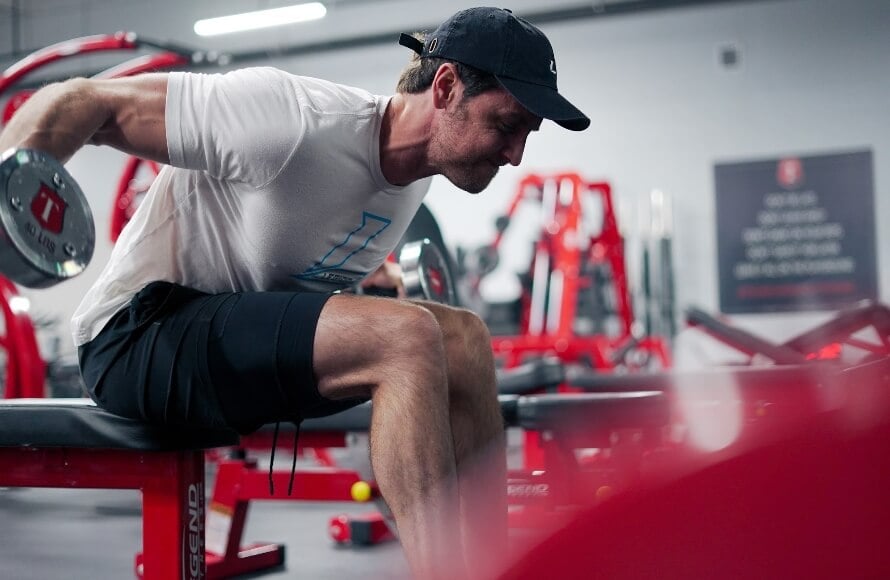
1. End every set 1-to-2 reps shy of muscle failure.
As I explain in my fitness books for men and women, to maximize your results, you must take most of the sets in your dumbbell shoulder workouts to within a rep or two of failure.
Ask yourself at the end of each set, “If I had to, how many more reps could I have gotten with good form?” If the answer is more than two, increase the weight or reps to make your next set more challenging.
READ MORE: Does Training to Failure Help You Build More Muscle? What Science Says
2. Once you hit the top of your rep range for one set, increase the weight.
If your shoulder workout with dumbbells calls for 4-to-6 reps of the seated shoulder press and you get 6 reps for a set, use dumbbells that are 5 pounds heavier for the next set.
If you manage 3 or fewer reps with the heavier dumbbells, go back to using the lighter dumbbells until you can press them for 2 sets of 6 reps before trying the heavier dumbbells again.
If you still can’t press the heavier dumbbells for a set of 4 reps, work with the lighter dumbbells until you press them for 3 sets of 6 reps.
By that point, you should be able to lift the heavier dumbbells for at least 3 sets of 4 reps (the bottom of your target rep range).
Follow this pattern of trying to add reps or weight to every exercise in every workout.
READ MORE: Double Progression Guide: How to Use Double Progression to Gain Muscle and Strength
3. Take the right supplements.
To get the most out of your shoulder training with dumbbells, consider the following three supplements:
- Protein powder: Protein powder, such as whey or casein, provides your body with the nutrients needed to build muscle tissue and recover from workouts. For a clean and delicious protein powder, try Whey+ or Casein+.
- Creatine: Creatine boosts muscle and strength gain, improves anaerobic endurance, and reduces muscle damage and soreness from your workouts. For a natural source of creatine, try our creatine monohydrate, creatine gummies, or Recharge.
- Pre-workout: A high-quality pre-workout enhances energy, mood, and focus, increases strength and endurance, and reduces fatigue. For a top-tier pre-workout containing clinically effective doses of 6 science-backed ingredients, try Pulse with caffeine or without.
(If you’d like even more specific advice about which supplements you should take to reach your health and fitness goals, take the Legion Supplement Finder Quiz, and in less than a minute, you’ll know exactly what supplements are right for you.)
Benefits of Dumbbell Shoulder Exercises
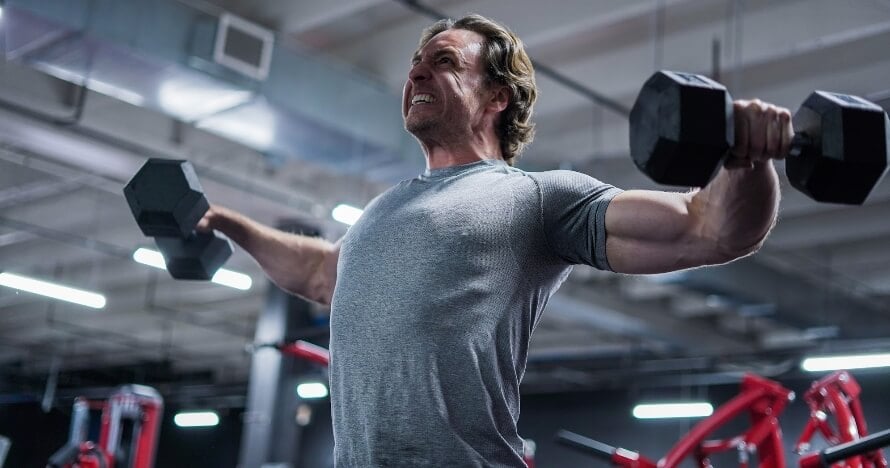
Dumbbell shoulder exercises offer several unique advantages over machines and barbells.
Let’s go over the main ones.
Unilateral Training
One of the biggest benefits of dumbbell shoulder exercises is that they let you train each side of your body independently, which helps you find and fix muscle and strength imbalances that can distort your physique and increase your risk of injury.
Greater Range of Motion
A barbell can limit your range of motion on some shoulder exercises. For example, in the barbell rear delt row, you must stop each rep when the bar touches your torso, even though you could comfortably pull the weight a few more inches.
Dumbbell shoulder exercises sidestep this issue because there’s no bar to hit your body, allowing you to train your muscles through a full range of motion and maximize muscle and strength gain.
Highly Versatile
Because dumbbells are more maneuverable than barbells, dumbbell shoulder exercises allow you to train through different ranges of motion, at varying angles, and using a range of grip orientations, which likely produces more balanced and complete muscle growth than taking a less varied approach.
Freedom of Movement
Dumbbell shoulder exercises give you the freedom to move in ways that feel natural for your body. You can adjust your grip and arm path to match your structure, which helps reduce joint stress and avoid discomfort.
Greater Muscle Activation
Dumbbell shoulder exercises force your body to stabilize each weight independently, which activates your muscles more than using a barbell or machine. This increased demand also recruits the smaller stabilizer muscles around your shoulders and shoulder blades to greater degree.
Over time, this can help improve shoulder stability, boost muscle gains, and reduce the risk of injury.
FAQ #1: Can you do shoulder workouts with dumbbells at home?
Yes—shoulder workouts with dumbbells at home can be highly effective. You can perform most dumbbell shoulder exercises standing, so you don’t need a bench. That said, if you have a sturdy chair with a backrest, you can still do seated presses safely and effectively.
If you only own one set of dumbbells, you may need to adjust the workouts a bit. For example, if the weight is too light for pressing in the 4-to-6 rep range, you can train in a higher rep range and take each set one rep shy of failure.
Or you can focus on isolation exercises that target each head of the deltoid. This approach isn’t ideal for gaining full-body strength, but it works well as a short-term option until you get access to heavier dumbbells or a gym.
FAQ #2: Can you build your shoulders only with dumbbells?
Yes—you can build strong, well-developed shoulders using only dumbbells. Dumbbell shoulder exercises allow you to train each head of the deltoid—front, side, and rear—as well as supporting muscles like the traps and rotator cuff.
As long as you follow a good dumbbell shoulder workout, lift heavy weights, and apply progressive overload, you can gain significant muscle and strength without ever picking up a barbell or using a machine.
FAQ #3: Is 3 exercises enough for a shoulder workout routine with dumbbells?
Yes—3 exercises can be sufficient for a shoulder workout routine with dumbbells, as long as they allow you to train each head of the delts. That typically means doing one exercise that emphasizes the front delts, one that emphasizes the side delts, and one that emphasizes the rear delts.
That said, adding a fourth exercise gives you more variety and allows you to train your shoulders from different angles, which can help improve overall development.
FAQ #4: How do you do a shoulder workout with one dumbbell?
You can do all the dumbbell shoulder exercises in this article one side at a time. Bear in mind, however, that using a single dumbbell for overhead presses requires more core stability and balance, which can take some getting used to.
For isolation movements like side and rear lateral raises, it’s usually no issue—you simply alternate arms and perform the same number of reps on each side.
Scientific References +
- Smita Maruvada, and Matthew Varacallo. “Anatomy, Rotator Cuff.” Nih.gov, StatPearls Publishing, 14 Nov. 2018, www.ncbi.nlm.nih.gov/books/NBK441844/.
- Saeterbakken, Atle H., and Marius S. Fimland. “Effects of Body Position and Loading Modality on Muscle Activity and Strength in Shoulder Presses.” Journal of Strength and Conditioning Research, vol. 27, no. 7, July 2013, pp. 1824–1831, https://doi.org/10.1519/jsc.0b013e318276b873.
- Raizada, Shiny , and Amritashish Bagchi. Comparison among the EMG Activity of the Anterior Deltoid and Medial Deltoid during Two Variations of Dumbbell Shoulder Press Exercise. Oct. 2017, https://doi.org/10.5958/0976-5506.2017.00411.9.
- Coratella, Giuseppe, et al. “An Electromyographic Analysis of Lateral Raise Variations and Frontal Raise in Competitive Bodybuilders.” International Journal of Environmental Research and Public Health, vol. 17, no. 17, 19 Aug. 2020, p. 6015, https://doi.org/10.3390/ijerph17176015.
- Campos, Yuri A. C., et al. “Different Shoulder Exercises Affect the Activation of Deltoid Portions in Resistance-Trained Individuals.” Journal of Human Kinetics, vol. 75, no. 1, 31 Oct. 2020, pp. 5–14, https://doi.org/10.2478/hukin-2020-0033.
- Kevin D. Sweeney, et al. “Impact of Shippers’ Choice on Transportation System Congestion and Performance”: Transportation Journal, vol. 53, no. 2, 2014, p. 143, https://doi.org/10.5325/transportationj.53.2.0143.
- Larsen Stian, et al. Dumbbell versus Cable Lateral Raises for Lateral Deltoid Hypertrophy: An Experimental Study. 17 Dec. 2024, sportrxiv.org/index.php/server/preprint/view/487, https://doi.org/10.51224/srxiv.487.
- McAllister, Matthew J., et al. “Effect of Grip Width on Electromyographic Activity during the Upright Row.” The Journal of Strength & Conditioning Research, vol. 27, no. 1, 1 Jan. 2013, pp. 181–187, journals.lww.com/nsca-jscr/Fulltext/2013/01000/Effect_of_Grip_Width_on_Electromyographic_Activity.25.aspx, https://doi.org/10.1519/JSC.0b013e31824f23ad.
- Jeno, Susan H, and Matthew Varacallo. “Anatomy, Back, Latissimus Dorsi.” Nih.gov, StatPearls Publishing, 5 Apr. 2019, www.ncbi.nlm.nih.gov/books/NBK448120/.
- Stokes, Tanner, et al. “Recent Perspectives Regarding the Role of Dietary Protein for the Promotion of Muscle Hypertrophy with Resistance Exercise Training.” Nutrients, vol. 10, no. 2, 7 Feb. 2018, p. 180, www.mdpi.com/2072-6643/10/2/180/pdf, https://doi.org/10.3390/nu10020180.
- Eckerson, Joan M., et al. “Effect of Creatine Phosphate Supplementation on Anaerobic Working Capacity and Body Weight after Two and Six Days of Loading in Men and Women.” The Journal of Strength and Conditioning Research, vol. 19, no. 4, 2005, p. 756, https://doi.org/10.1519/r-16924.1.
- Bloomquist, K., et al. “Effect of Range of Motion in Heavy Load Squatting on Muscle and Tendon Adaptations.” European Journal of Applied Physiology, vol. 113, no. 8, 20 Apr. 2013, pp. 2133–2142, link.springer.com/article/10.1007%2Fs00421-013-2642-7, https://doi.org/10.1007/s00421-013-2642-7.
- Costa, Bruna Daniella de Vasconcelos, et al. “Does Performing Different Resistance Exercises for the Same Muscle Group Induce Non-Homogeneous Hypertrophy?” International Journal of Sports Medicine, vol. 42, no. 09, 13 Jan. 2021, pp. 803–811, https://doi.org/10.1055/a-1308-3674.










